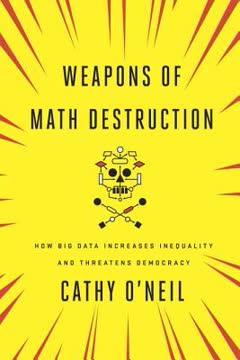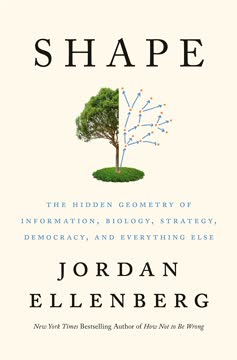Key Takeaways
1. Logic is the foundation for clear thinking and understanding
Logic is to mathematics as evidence is to science.
Logical thinking power. Logic provides a framework for constructing rigorous arguments and reaching sound conclusions. It allows us to move from known truths to new insights through careful deduction. However, logic has limits and starting points (axioms) that cannot be proven logically.
Practical applications. In everyday life, logic helps us:
- Analyze complex situations
- Identify flaws in arguments
- Make better decisions
- Communicate more clearly
While perfect logic is impossible in the messy real world, striving for logical clarity improves our ability to navigate difficult issues and disagreements.
2. Abstraction allows us to apply logic to real-world situations
Mathematics in school may well be mostly about numbers and equations, but higher-level mathematics is about how to think, and in this way it is applicable to the entire human world, not just the part involving numbers.
Bridging concepts. Abstraction involves identifying common patterns or principles across different situations. This allows us to apply logical reasoning to complex real-world problems by focusing on their essential features.
Key benefits of abstraction:
- Simplifies complex systems
- Reveals underlying structures
- Enables analogical thinking
- Facilitates problem-solving in diverse domains
By abstracting away irrelevant details, we can apply mathematical and logical thinking to areas like social issues, relationships, and decision-making processes.
3. Blame and responsibility are often more complex than they appear
Outcomes are always caused by whole systems, but we can still as individuals take responsibility for change.
Systems thinking. Most situations result from multiple interconnected factors, not a single cause. Understanding these systems helps us avoid overly simplistic blame and find more effective solutions.
Key aspects of systemic responsibility:
- Identifying multiple contributing factors
- Recognizing feedback loops and interactions
- Considering both individual and collective responsibility
- Focusing on changing the system rather than assigning blame
By adopting a systems perspective, we can address complex issues more effectively and avoid unproductive finger-pointing.
4. Relationships and interactions are key to understanding systems
Looking at how things or people relate to one another is often the key to understanding a situation, more than looking at the intrinsic characteristics of those things or people.
Interconnectedness. Focusing on relationships and interactions, rather than isolated components, reveals crucial insights about complex systems. This approach, inspired by category theory in mathematics, applies to social, technological, and natural systems.
Benefits of relationship-focused analysis:
- Reveals emergent properties
- Identifies key leverage points for change
- Improves predictive power
- Facilitates interdisciplinary understanding
By examining how elements relate and interact, we gain a more holistic and actionable understanding of complex situations.
5. Personal axioms shape our beliefs and arguments
Axioms in mathematics are analogous to our personal core beliefs.
Foundational beliefs. Our fundamental assumptions, often unconscious, shape our logical reasoning and arguments. Identifying these axioms helps us understand the roots of disagreements and our own thought processes.
Strategies for uncovering personal axioms:
- Repeatedly asking "why?" to trace beliefs to their source
- Examining emotional reactions to identify underlying values
- Comparing beliefs across different contexts
- Considering how upbringing and experiences shape core beliefs
Understanding our own axioms and those of others enables more productive dialogue and potential for changing deeply held beliefs.
6. Gray areas and nuance are essential in logical thinking
Being able to imagine a skeptical person arguing with you is a good way to test your logic in life as well.
Embracing complexity. Real-world situations often involve nuance and gray areas that defy simple black-and-white logic. Acknowledging this complexity leads to more robust and useful logical thinking.
Strategies for dealing with gray areas:
- Using fuzzy logic or probabilistic reasoning
- Considering multiple perspectives
- Identifying relevant context and constraints
- Recognizing limits of certainty
By embracing nuance, we avoid oversimplification and develop more sophisticated, applicable logical frameworks.
7. Analogies can bridge abstract concepts and emotional understanding
Analogies can help us to engage our emotions, if we can find an analogous situation that resonates more closely with us.
Emotional resonance. Analogies connect abstract ideas to more familiar or emotionally charged situations, making them more relatable and persuasive. This bridges the gap between logical arguments and emotional understanding.
Effective use of analogies:
- Identify core principles or structures
- Find situations with similar underlying patterns
- Ensure the analogy doesn't break down in crucial ways
- Use analogies to evoke empathy or new perspectives
Well-chosen analogies can make complex ideas more accessible and emotionally compelling, enhancing both understanding and persuasion.
8. False equivalences and dichotomies hinder productive discourse
A false dichotomy is when you think the options are perfectly cleanly split between A and B, but in reality they are not.
Logical fallacies. False equivalences and dichotomies oversimplify complex issues, leading to unproductive arguments and polarization. Recognizing these fallacies improves the quality of discourse and decision-making.
Common types of false equivalences and dichotomies:
- Treating unlike things as identical
- Presenting only two extreme options
- Ignoring nuance or middle ground
- Equating correlation with causation
By identifying and avoiding these fallacies, we can engage in more nuanced, productive discussions and find common ground on complex issues.
9. Emotions and logic are not opposites, but complementary tools
Emotions do not lie. They are never false. If you feel something you are definitely feeling it.
Integrated thinking. Emotions and logic work together in human cognition. Emotions can guide intuition, provide motivation, and help us connect with others. Logic helps us analyze and verify our emotional insights.
Ways emotions and logic complement each other:
- Emotions highlight important issues for logical analysis
- Logic helps explain and understand emotional reactions
- Emotional engagement makes logical arguments more persuasive
- Integrating both leads to more holistic decision-making
By embracing both emotion and logic, we can develop more robust, persuasive, and human-centered approaches to problem-solving and communication.
Last updated:
FAQ
What's The Art of Logic in an Illogical World about?
- Exploring Logic's Role: The book examines how logic can help us navigate the complexities of an often illogical world, emphasizing the importance of distinguishing between fact and fiction.
- Interplay of Logic and Emotions: Cheng argues that logic must be combined with an understanding of emotions to be effective in real-world discussions, highlighting their interconnectedness.
- Mathematics as a Framework: The author uses her mathematical background to illustrate logical argument construction, providing a framework applicable beyond mathematics.
Why should I read The Art of Logic in an Illogical World?
- Enhance Critical Thinking: The book aims to improve your ability to think critically and clearly, crucial in a world filled with misinformation.
- Understand Complex Issues: Cheng provides tools to analyze controversial topics like sexism and racism logically, leading to more constructive discussions.
- Practical Applications: Insights from the book can be applied to everyday situations, helping navigate arguments and disagreements effectively.
What are the key takeaways of The Art of Logic in an Illogical World?
- Logic's Power and Limits: While logic is powerful for understanding truth, it has limitations, especially with human emotions and social issues.
- Importance of Context: Understanding the relationships between factors is crucial for grasping the full picture of any situation.
- Combining Logic and Emotion: Logic and emotions can work together to foster better understanding and communication.
What are the best quotes from The Art of Logic in an Illogical World and what do they mean?
- "Logic makes our arguments rigorous but emotions make them convincing.": Highlights the need for both logical reasoning and emotional intelligence in communication.
- "Mathematics is the logical study of how logical things work.": Emphasizes that mathematics is about understanding relationships and logical structures.
- "If we push our use of logic too far we risk oversimplifying the situation.": Warns against applying logic without considering human experience and emotion complexities.
How does The Art of Logic in an Illogical World address the relationship between logic and emotions?
- Interconnectedness of Logic and Emotion: Emotions play a significant role in perceiving and communicating logical arguments.
- Using Emotions to Enhance Logic: Emotions can support logical arguments, making them more relatable and convincing.
- Avoiding Emotional Manipulation: Advocates for a balanced approach that respects both logic and emotional responses.
What are some examples of logical fallacies discussed in The Art of Logic in an Illogical World?
- Straw Man Fallacy: Misrepresenting an opponent's argument to make it easier to attack, detracting from meaningful discourse.
- Ad Hominem Attacks: Personal attacks on an individual rather than addressing their argument can derail logical discussions.
- False Equivalence: Equating two unequal things can lead to misleading conclusions and hinder understanding of complex issues.
How does The Art of Logic in an Illogical World define logic?
- Systematic Reasoning: Logic is a systematic method of reasoning that allows conclusions based on established premises and rules.
- Foundation for Arguments: Described as the foundation for constructing arguments, enabling clear communication and understanding.
- Abstract Framework: Operates in an abstract realm, allowing exploration of ideas without real-world complexities.
What role do axioms play in The Art of Logic in an Illogical World?
- Starting Points for Logic: Axioms are fundamental truths serving as starting points for logical reasoning and mathematical proofs.
- Influence on Logical Systems: The choice of axioms can shape the entire logical system, highlighting the subjective nature of truth.
- Limitations of Logic: Axioms illustrate the limits of logic, as they require acceptance without justification.
How does The Art of Logic in an Illogical World suggest we improve our logical reasoning skills?
- Practice Constructing Arguments: Encourages building logical arguments and identifying fallacies in everyday discussions.
- Engage with Different Perspectives: Advocates for engaging with diverse viewpoints to challenge beliefs and improve understanding.
- Combine Logic with Emotional Intelligence: Emphasizes integrating emotional intelligence with logical reasoning for effective communication.
What are the limitations of logic as discussed in The Art of Logic in an Illogical World?
- Inability to Address Emotions: Logic alone cannot account for emotional aspects crucial for understanding social issues.
- Complexity of Real-World Situations: Real-life situations often involve multiple factors that logic cannot fully capture.
- Dependence on Context: Without considering the broader context, logical arguments can become misleading or irrelevant.
What is the significance of Gödel’s incompleteness theorem in The Art of Logic in an Illogical World?
- Limits of Logical Systems: Demonstrates that no logical system can be both complete and consistent, with truths eluding formal proof.
- Implications for Mathematics: Suggests inherent limitations to what can be known or proven in mathematics.
- Broader Philosophical Insights: Explores philosophical questions about knowledge, truth, and reality, encouraging reflection on human understanding limits.
How can I apply the concepts from The Art of Logic in an Illogical World in my daily life?
- Practice Balanced Reasoning: Balance logic and emotions in discussions, recognizing the value of both in understanding issues.
- Engage in Nuanced Conversations: Approach conversations with an open mind, acknowledging gray areas in arguments.
- Reflect on Personal Beliefs: Use the book's frameworks to examine beliefs and be open to change based on new evidence.
Review Summary
The Art of Logic in an Illogical World receives mixed reviews. Some praise Cheng's clear explanations of logical concepts and their applications to real-world issues. Others criticize her perceived political bias and repetitive writing style. Many appreciate the book's accessibility but find it too basic or lacking in depth. Some readers value Cheng's personal examples, while others find them distracting. Overall, reviewers agree the book offers useful insights into logical thinking but disagree on its effectiveness in addressing complex societal issues.
Similar Books










Download PDF
Download EPUB
.epub digital book format is ideal for reading ebooks on phones, tablets, and e-readers.







